Open for business!
I've done a few tree jobs for select customers as I didn't have tickets, insurance, trucks, chippers, trailers and all the things that you need to do arb work. However, now I am totally legit.
So after two years of college and various trial by fires, I am delighted to say I am now officially open for business doing domestic and commercial tree work with my properly insured, incorporated, vat registered limited company - Life of Treedom LTD. It’s been a long journey in some senses and in others it feels like time has flown by.
The first Job
One of the bread and butter jobs in tree world is referred to as “conny bashing”. In plain english that translates to removing conifers that have overgrown a space. I’ve groundied on loads of them, but this job was mine. I was to be the climber. The tree in question belonged to a customer in Newcastle Upon Tyne.

I was first offered the job in 2023. I nearly took it on and my plan was simply to ram the tree into the back of the rav4 and do ten thousand journeys to the woodland where presumably some magic would take place and it would be magically transformed into woodchip. Thankfully I came to my senses and declined the job on the condition that I’d be available to do it in the summer of 2024.
True to my word, twelve months later, I returned and the tree was six foot bigger in all directions. I was nervous about this job and I made no secret of sharing that with you all. However, as it turns out, there was no need for the pre-job nerves as it all went out without any of those fears coming true. It didn’t go according to plan though, more on that later.
Set up
We arrived at the job for 9:30 and got ourselves properly set up. Check me out - chevrons, cordoned off area and signage at both ends of the public highway. Yes, that came out of the risk assessment.
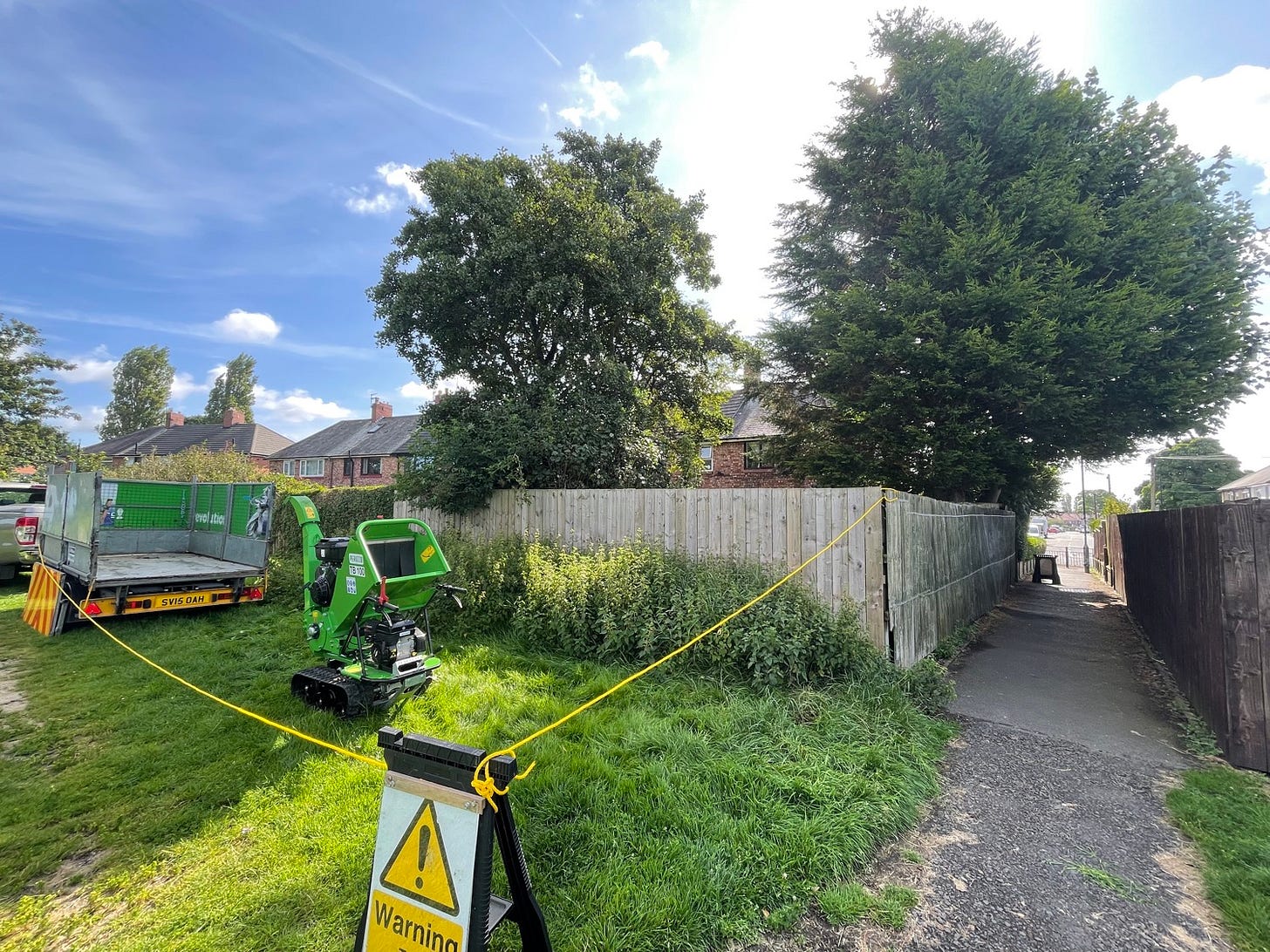
On a job like this you need a minimum of two people – a climber and groundie. Technically your groundie needs to have a climbing ticket so that in the event you get injured, you can be rescued. Jacob does because I’m starting off as I mean to go on with this tree company of mine (let’s call it the business) and I plan to do all the necessary audits and best practice to get the business approved as an “arb approved contractor”. I’ll write about why at a later point but the way I see it is that I want to operate at a certain standard, at a certain price point for people who value the work. It’s a big topic, so that’s all I will say for now. The guy I was working with is known to me, he’s called Jacob and I was his groundie whilst I was doing my work experience at the tree company.
Up
The process on a removal of a leylandii is straight forward. You put on your climbing spikes, get a strop (ideally steel core) and spike up the tree. In the UK you also use a secondary line in case you do something dumb like cut through your strop. Easily done on a rope strop, harder to do on a steel core. Despite the fact the below picture shows a standard strop (the green rope), I was using an orange steel core strop for the bulk of the day.
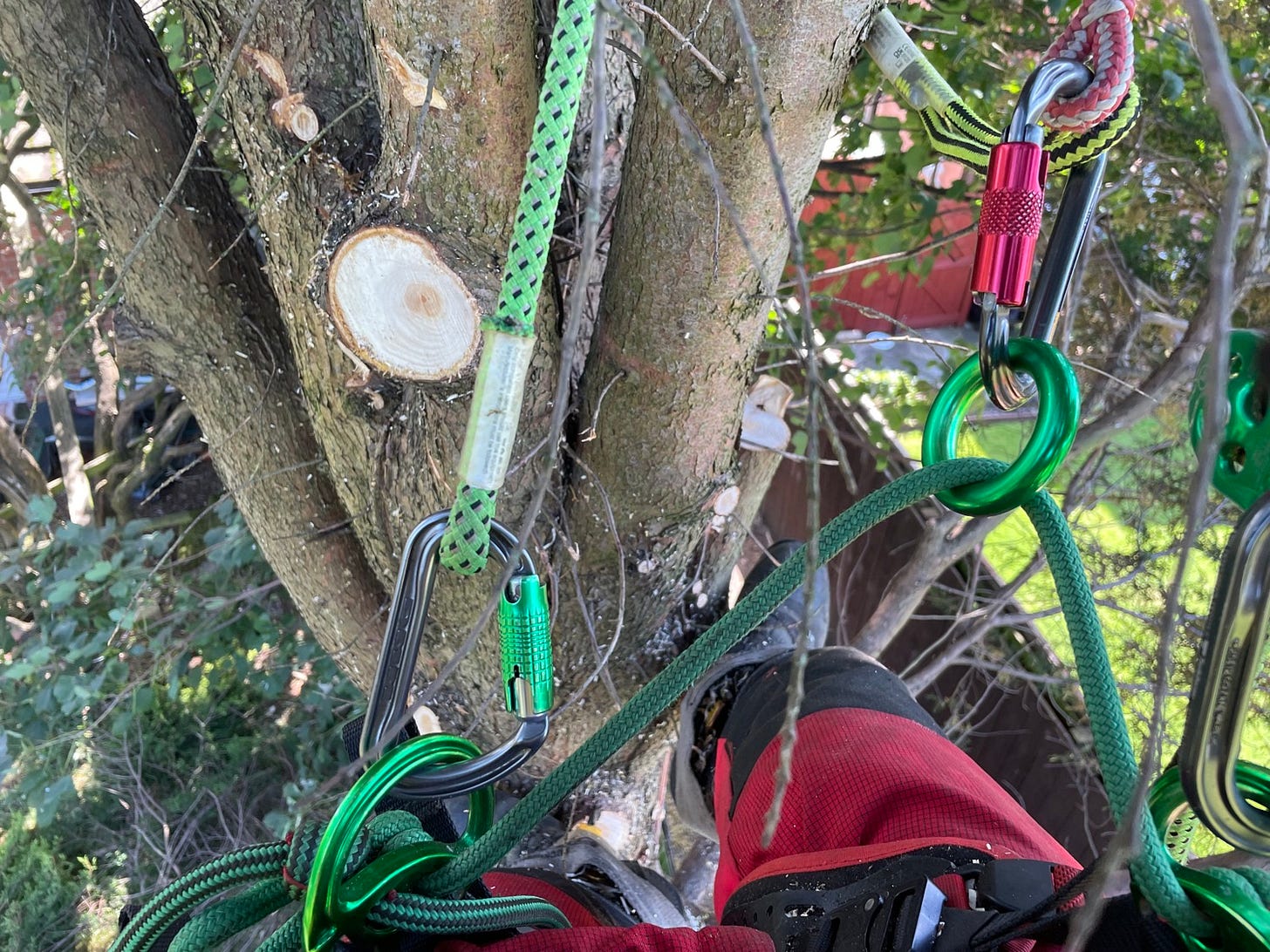
Once you start ascending the tree you are basically removing every limb as you ascend. The game is to make sure you’re not swamping your groundie with too many limbs and to always pay attention to their location so you don’t drop limbs on the their head. Shouting “clear” is a polite thing to do, as is ensuring the limbs fall with the end of the cut branch facing the groundie. Limbs go into a chipper branch end first. If you drop them so that they land like this, everything goes faster and you save about 50% of your groundies energy. Here’s Jacob taking first blood with the treedom chipper. I’m gonna write something up about this thing. For what it does, it’s a monster.
The Top
Once all the limbs are removed, you get to a point where you cannot go any higher – the top of the tree. In this case, the tree had six tops because that’s what this species does. The view at the top was nice. If you’re a local to the area you can probably work out the location.
I’ll be honest, I don’t have my rigging ticket and I wasn’t going to rig anything down, but I knew in my heart of hearts that not rigging the tops down was reckless so I decided to rig the tops out. I don’t have fancy pants arb rigging gear which is feather light (so you can climb up with it on your harness) and quick to set up (the last thing you want is a fiddly setup when you’re at the top). All I have is my forestry gear, which whilst being correctly rated and totally legit, is basically heavy, fiddly and a challenge to work with at height.
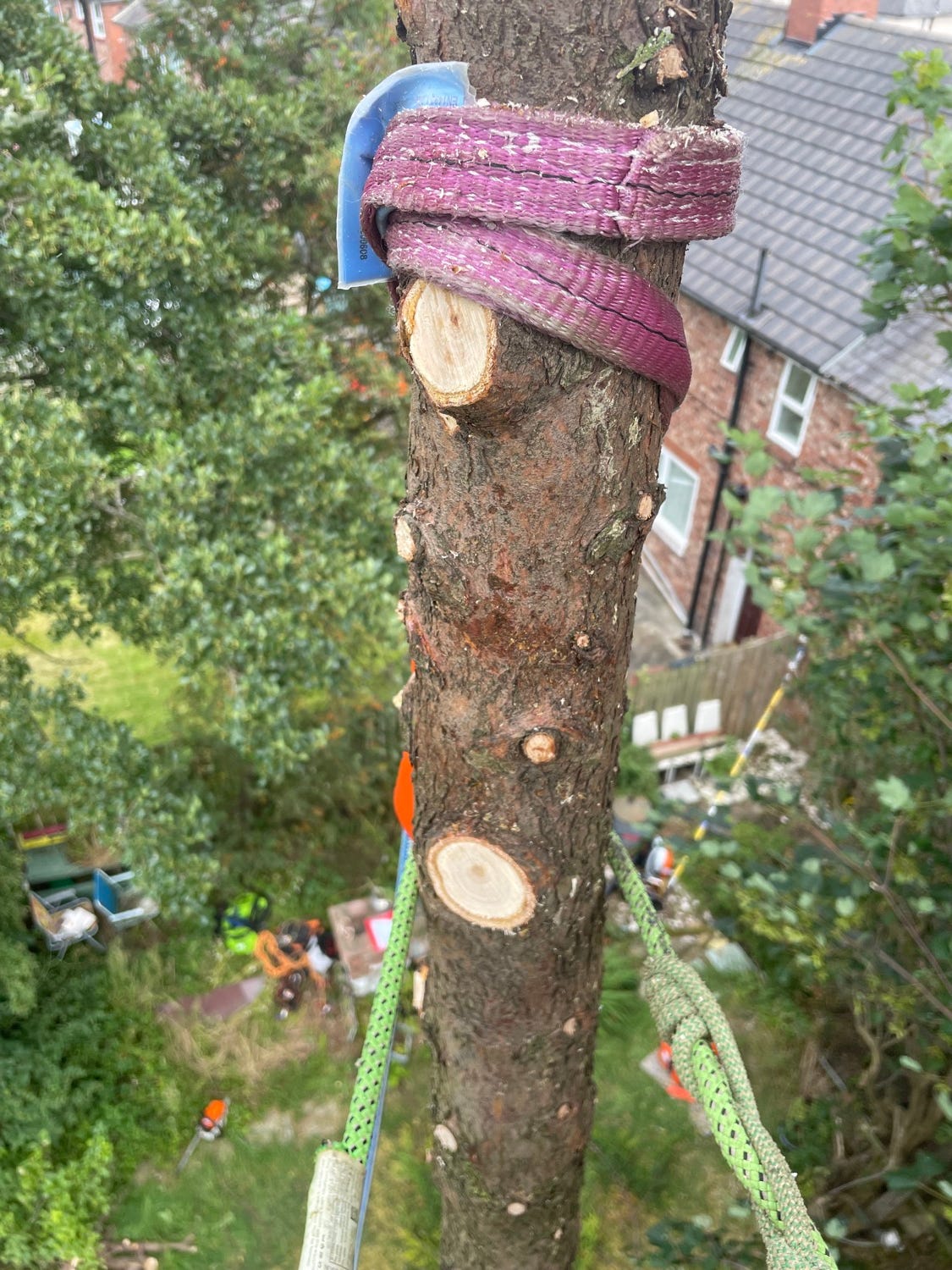
The tops were about five inches where I was spiked onto, and the wind was yarking me about a bit. The process for doing tops is pretty straight forward. You place the rigging system beneath (hence the term negative rigging) where you’re going to cut. Then you put your face cut in. The face cut must be deep enough to give the top the momentum, but not so deep that the top falls out without being tied into the rigging system. It is hoop twitching stuff I tell you.
Once the face cut is in you connect the rope. A half hitch finished off with a running bowline and if you’re being fancy pants – which I was – a stopper knot. The system was good for 71kg when accounting for force multipliers. This was more than ample as the tops were probably about 40kg max.
Once you have done your rope work you do the back cut and it should - at least in theory - fall forwards into the face cut. The first top did just this, The second top didn’t. The wind got it and tried to push it backwards, but I got in there and muscled it against the wind and it went down fine. Top three was fine. The other tops were small enough for me to cut and throw down. One thing that is worth mentioning is that when negative rigging, especially tops, the groundies job is the most important. They have to know to “let the rope run” just enough so that the top gradually slows down on its way to the ground. It’s a hard thing to learn and you only learn by doing wrong a few times. If your groundie holds that rope tight and doesn’t allow the rope to run, the top falls out and then shock loads the system which then shakes the stem. Watch any video on YouTube with tree cutting fails and you’ll see an example.
With Jacob running the ropes though, it was joyful. When you negative rig something, especially a top, the buzz is outstanding. One second there was a tree, the next there is a pole and you know your job is half done. The saw, the ropes, the wobbling stem and the heights all create a buzz that is addictive. Here’s a photo of me buzzing after top two went down. Wild Eyes.
Down
When the tops are out it is case of chunking down the tree in sections. It is called “chogging”. I got the big 462 out for this job as it requires some power. It’s a bitch to start when dangling from a rope, but it is a fast cutter. However, all did not go according to plan.

In a nutshell, the vitally important – but TINY – circlip that holds the chainsaw clutch system together must have either snapped, or wasn’t properly put on by yours truly when I maintained the saw a few weeks ago. At first I noticed a slack chain which I tightened up. Problem solved I thought. Wrong. Then I noticed smoke (never a good sign) and I could feel the bar and chain were red hot. Oh dear, no oil to the bar - the bar must be blocked, so I passed the saw down to Jacob to fix. That’s when we realised the entire clutch assembly had shattered. So I had to finish the chogging with a tiny bar (which took ages). Oh well, at least I had the smaller 261 with me – “one is none” as they say. That clutch is gonna cost me about £60 to repair. Bugger. Oh well, shit happens.
Terra Firma
Finally, after I was up for about four hours we got down to the height where I could fell the stem. After being on spikes for half a day, there’s no feeling like walking on the ground again. Pure bliss.
I felled the stem super high because the customer asked me if I could make a seat from the lower half of the stem. I was delighted to. One of the things behind the name “Life of Treedom” is the idea that there is no waste. So when a customer asks if they can have a seat from what would be ultimately a waste product, it is a win win. I have less to cart off and they have something to remember the tree by.
Waste (or not)
No waste is a key concept. I meant to get a picture of the trailer full of chip, but I forgot because I was under a time pressure to get the woodchip to a local allotment where it was to be used for paths and mulching. The recipients got a few hundred kilograms of woodchip for free and I got to tip the trailer locally. Winner winner chicken dinner.
All that was left was “the heavy” and the final dumpy bag of crap. The heavy is the name given to the collection of logs that are too big for the chipper, which for me is pretty much everything over three and half inches. My chipper is a teeny tiny one, but it also had a teeny tiny price - £5000 second hand with forty hours on it rather than £20,000 second hand for a similarly used on one capable of eating stuff up to six inches. I’ll take the £5000 one for starting out.
Time was cracking on and we had to get home. I couldn’t put the heavy in the trailer as the chipper was in there. It’s a bit of a chicken and egg situation that I’ll write about soon. So the heavy stayed for the night in a public place in Newcastle. I’ll be honest, I was hoping it would be gone the next day as frequently this happens when firewood sized rounds are left for everyone to steal.
The next day
Sadly, when I drove back to the job the next morning all the heavy was there, so I loaded it all into the trailer and drove it down to treedom woods. This was my first big load with the trailer and the truck. It‘s a 3.2 litre diesel capable of towing 3500kg. The trailer weighs 800kg and I suspect I had about 1200kg of wood on back. It wasn’t as scary to drive as I thought, but you really do need to drive differently when you’re pulling a load like this. Slow and steady wins the race.
I tipped the load out (the trailer is a fancy pants hydraulic tipper one) and decided to use the rounds to line the parking space. Leylandii is a weird mix of Cuppresso and Cyprus. It is an oddity in that it is a rare case of species hybridisation and whilst it gets a lot of hate for its incorrect use in the urban context, it is actually a very nice rot resistant wood. You wouldn’t want to make cabinets out of it, but in an outdoor setting it’s great - especially for that “woodland vibe”
Getting out was fun. I had to reverse the trailer into a very tight space between the oak logs and the alder tree. Reversing trailers is hard and I did burn the clutch a bit doing this. Gah. I really must get the turning circle sorted at the woodland. Ideally I want to be able to drive up to the woodland, get into the turning circle, dump my load and leave. Once in a while I’ll take the chipper to the woods and chip the brash onto the rides. This is all future stuff though.
That’s a wrap and a new beginning.
I wanted to share with you all the first tree job and to declare that I am now open for business. I’ll be only be doing Saturdays and Sundays for the next few years as I start teaching at treeschool three days a week and I’m working the estate two days a week. Something is gonna have to give, but I’m going to give it some time. For now I will limit the treework so that I can give the business proper roots.
Anyway, I’m at the end and normally I’d get Mrs Treedom to proof read but it’s half six on a Sunday, I’m back from another job (which I will write about later, but in short I’ve spent all day thinning an oak woodland where I managed to fell, process and stack the wood from one tree every 9.2 minutes for six hours straight) and I have to put my gear away and cook dinner. So I’m just going to press send and fix the typos later.
But yay - first job done and I am now open for business!
Thanks for reading,
Cheers,
Jamie



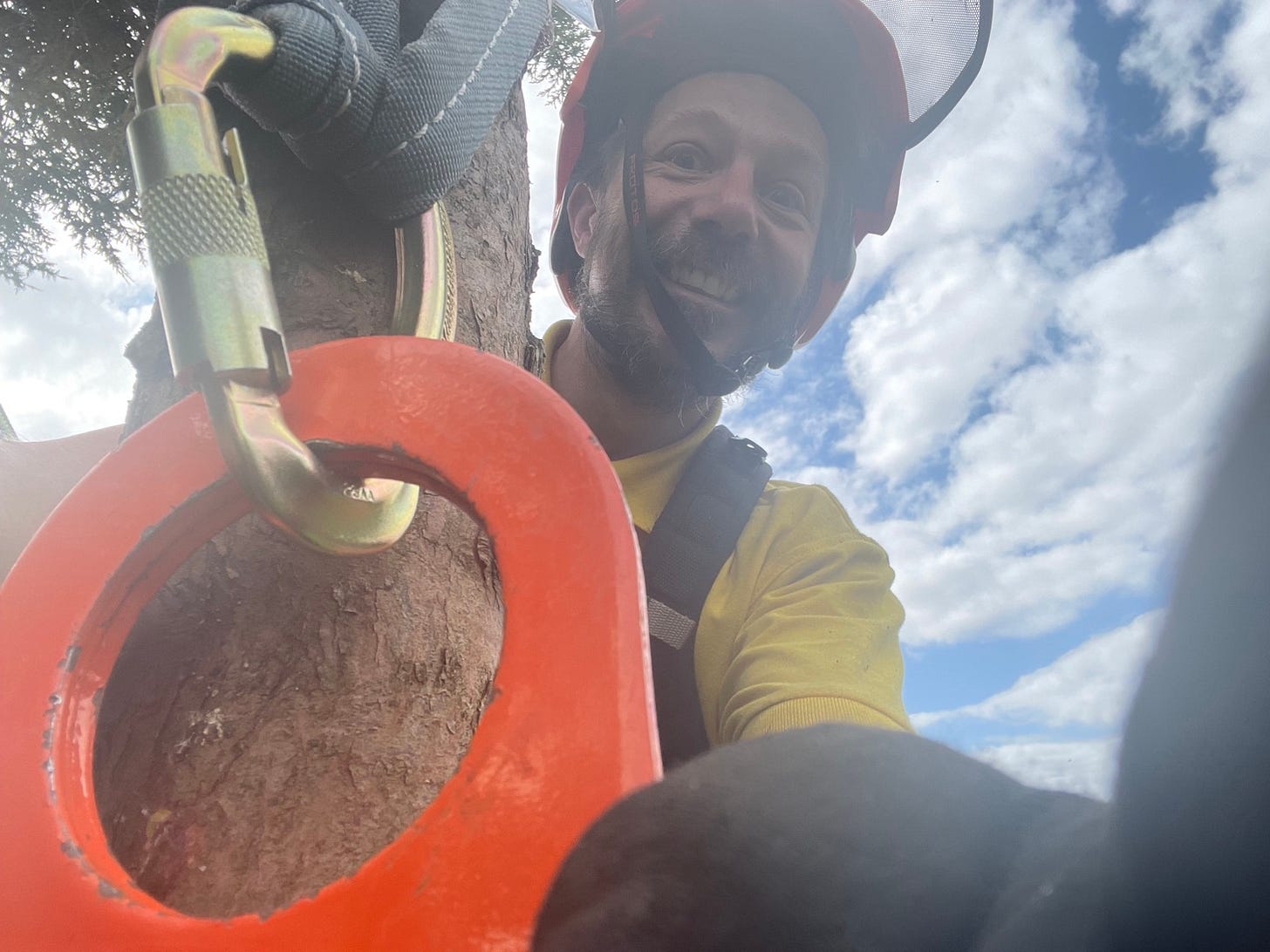

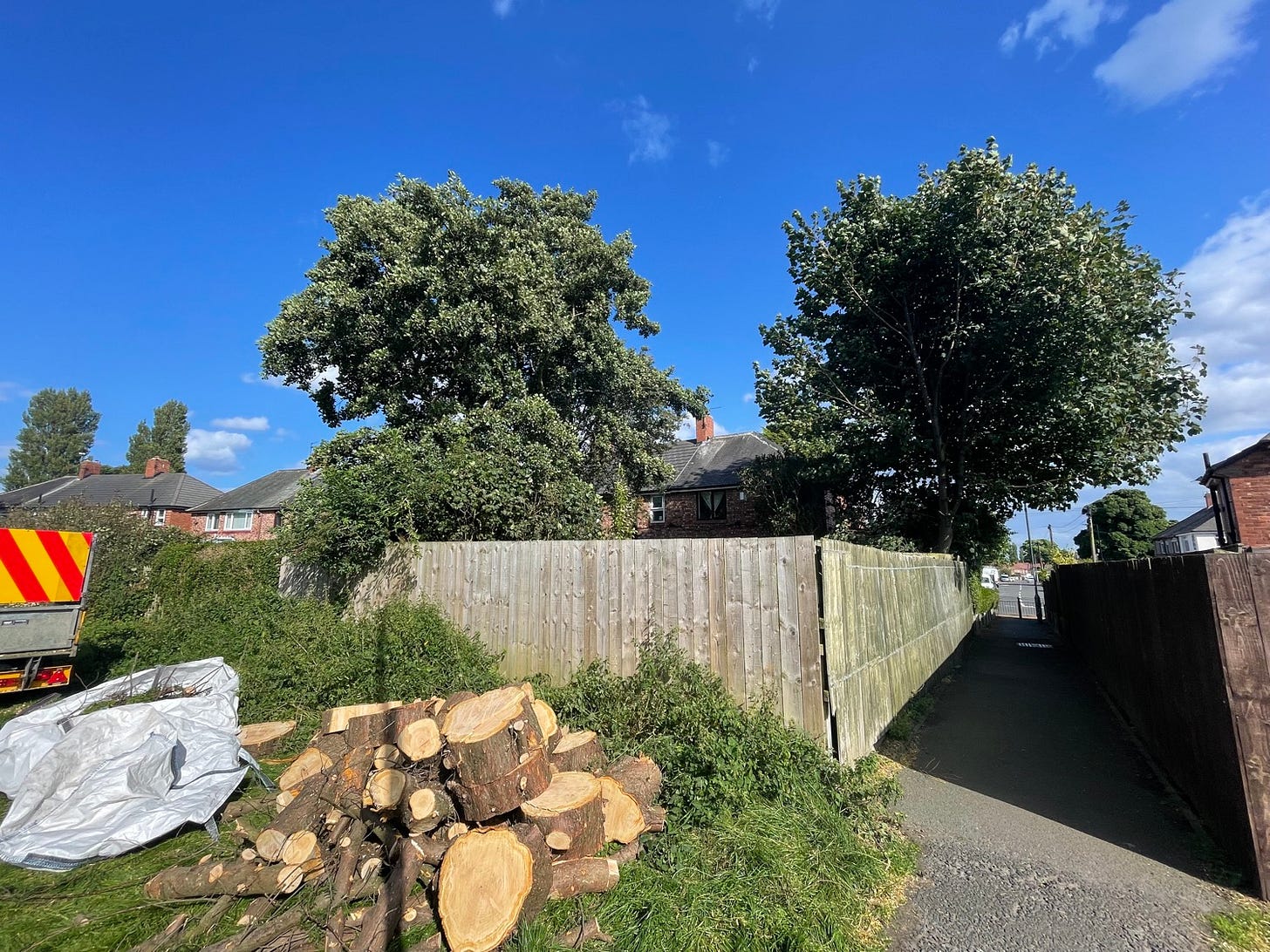
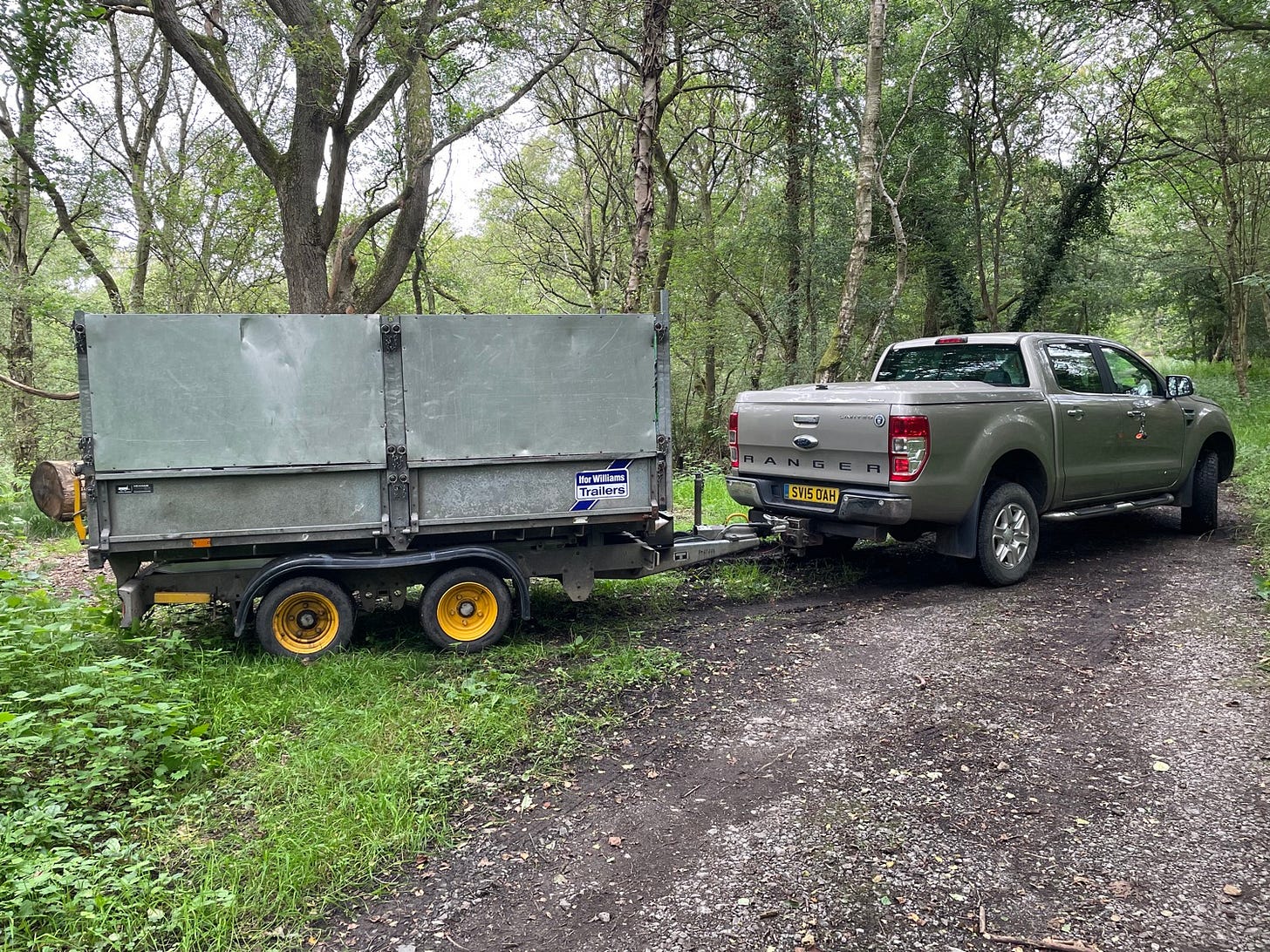
Congrats!
I enjoyed that - good read :-)